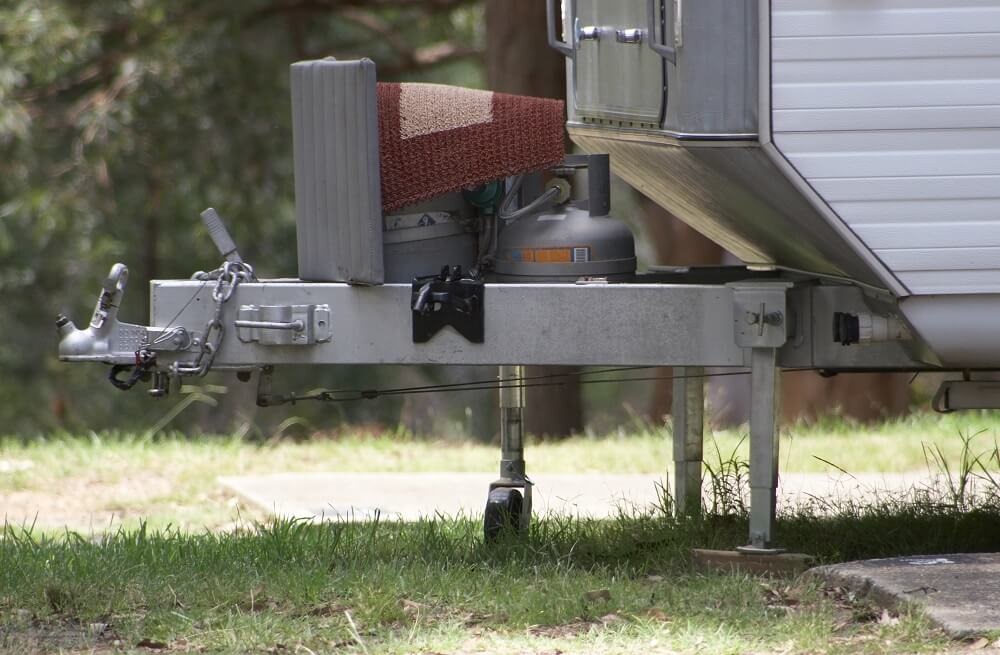Transporting gas cylinders

Planning a road trip in a caravan or going camping? Chances are you’ll take gas bottles with you to power appliances.
Whether you’re powering a gas stove, a lantern, or any other gas-powered camping appliance, make sure you know how to transport LPG cylinders safely.
Queensland law allows the transport of two 9kg cylinders in an enclosed vehicle.
But, as LPG is highly flammable, RACQ doesn’t recommend transporting cylinders in an enclosed vehicle in case there is a leak.
Gas cylinders must be stored and secured upright in the vehicle with a plug firmly fitted to the valve to reduce the risk of leaks.
RACQ Principal Technical Researcher Russell Manning said it was essential gas cylinders were stored and transported safely and correctly, as incorrect handling could lead to dire consequences.
“Let’s not sugar coat this, people have been killed and seriously injured by gas cylinders,” Mr Manning said.
“They are perfectly safe if handled correctly, but they can be extremely dangerous if not afforded the proper respect.”
Mr Manning said most people did not understand the contents of a gas cylinder expanded 270 times when released into the atmosphere.
“That’s a pretty big cloud of highly flammable gas to deal with, particularly if it’s in a closed space, which is why we don’t recommend transporting cylinders inside cars,” he said.
“It’s also important to not lay the gas cylinders on their sides as this can impair the proper operation of the cylinder’s safety valve.
“Keep the bottles cool and don’t leave them in vehicles unnecessarily.”
If you’re moving states, most removalist companies will not transport cylinders. Instead, most gas suppliers operate an exchange system, where you can surrender your cylinder in one city and receiver a voucher to pick up a replacement cylinder in another.
Gas bottle safety tips
- Check the cylinder’s test date. Gas cylinders have a test life of 10 years which is stamped on the cylinder. After 10 years the cylinder must be tested to confirm it is still safe. You won’t be able to get an out-of-date cylinder refilled.
- Listen for leaks and check for smells before transporting. LP gas on its own is odourless, so manufacturers add a chemical called methyl mercaptan which has a strong rotten egg or cabbage-like smell. If you smell this, you have a leak and need to close the cylinder valve and let the gas disperse.
- Test for leaks. The best way to find the source of a leak is to use a spray bottle with soapy water. Spray the soapy water around the hose, the regulator and the connections, and particularly around the cylinder connection.
- Turn on the gas for a safety check. Turn the gas on and check for bubbles which will indicate the source of the leak. Once you have determined the source of a leak, you can attempt to tighten the connection or replace the part and repeat the above steps until no bubbles appear. Remember systems carrying fuel gasses, such as LPG, use left-hand threads which will tighten in the opposite direction.
Related topics
Things to note
The information in this article has been prepared for general information purposes only and is not intended as legal advice or specific advice to any particular person. Any advice contained in the document is general advice, not intended as legal advice or professional advice and does not take into account any person’s particular circumstances. Before acting on anything based on this advice you should consider its appropriateness to you, having regard to your objectives and needs.
Insurance Products (excluding Travel Insurance) are issued by RACQ Insurance Limited ABN 50 009 704 152 (RACQI) and arranged by its agent, RACQ Distribution Services Pty Ltd (RDS) ABN 35 116 361 650, AFSL 567130 and RDS' authorised representatives (including RACQ Operations Pty Ltd ABN 80 009 663 414, AR No. 234978 (RACQO). Conditions, limits and exclusions apply. RDS and RACQO are in the RACQ group of companies. One of the companies in the RACQ group of companies has a minority shareholding in RACQI.
RDS and RACQO have not taken your personal objectives, circumstances or needs into account when preparing advice regarding insurance products and you will need to consider whether the advice is appropriate for you. Read the Product Disclosure Statement (PDS) and any applicable Supplementary PDS before making a purchase decision on this product. You can also access our Target Market Determinations on this website. RDS receives a commission from RACQI for the policies it arranges. RACQO receives fees paid for services it provides to RDS. Further details about remuneration are available on request prior to purchasing.
Banking and loan products issued by Members Banking Group Limited ABN 83 087 651 054 AFSL/Australian credit licence 241195 trading as RACQ Bank. Terms, conditions, fees, charges and lending policies apply. This is general advice only and may not be right for you. This information does not take your personal objectives, circumstances or needs into account. Read the disclosure documents for your selected product or service, including the Financial Services Guide and the Terms and Conditions, and consider if appropriate for you before deciding.
Except for RACQ Bank, any RACQ entity referred to on this page is not an authorised deposit-taking institution for the purposes of the Banking Act 1959 (Cth). That entity’s obligations do not represent deposits or other liabilities of RACQ Bank. RACQ Bank does not guarantee or otherwise provide assurance in respect of the obligations of that entity, unless noted otherwise.
RACQ Bank subscribes to the Customer Owned Banking Code of Practice which establishes higher standards than the law requires. The Code reflects modern consumer expectations and developments in approaches to issues such as consumer vulnerability, guarantors, and supporting customers through financial hardship. Please read our Customer Owned Banking Code of Practice page for more information.
RACQ Operations Pty Ltd (ABN 80 009 663 414 AR 000234978) and Members Travel Group Pty Ltd (ABN 45 144 538 803 AR 000432492) are acting as an Authorised Representative of the issuer of the insurance, Tokio Marine & Nichido Fire Insurance Co., Ltd. (ABN 80 000 438 291 AFSL 246 548). Any advice set out above is general in nature only, and does not take into account your objectives, financial situation or needs. Before purchasing any travel products, please consider the RACQ Travel Insurance Product Disclosure Statement (PDS) and the Target Market Determinations (TMDs) that apply to these products. Whilst the PDS outlines the Terms and Conditions of these products, the TMDs outline the intended class of customers that comprise the target market for these travel products. This will allow you to consider which products best suit your objectives, financial situation and needs and consider the products appropriateness to your personal circumstances. TMDs also outline matters involving the distribution and the review of these products. The PDS, Supplementary PDS and TMDs for each travel product can be found here.
